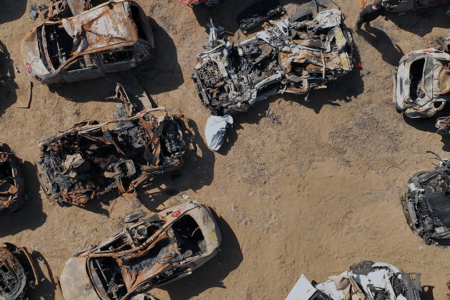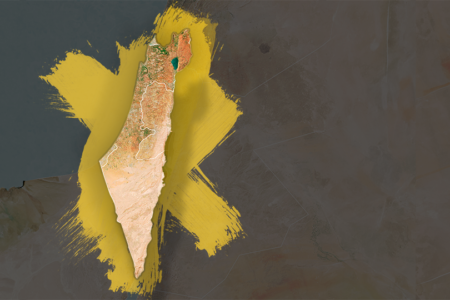The Golden Lampstand: Christ The Light of Life Exodus 25:31-40, 37:17-24; 39:37
Cleansed after washing at the brazen laver the priest reverently made his way a few feet towards the tabernacle entrance. His heart pounded with anticipation as he carefully drew back the heavy curtain of the tabernacle and entered to minister in the holy place. A hush fell over him as he contemplated the privilege and responsibility of representing his people before a holy God. In a spirit of humility he would worship and commune with the true and living God.
The tabernacle was a rectangular building divided into two sections: the holy place (30 feet long and 15 feet wide) and the holy of holies (15 feet square). The holy place and the holy of holies were divided by a huge heavy veil made of blue, purple, scarlet and finely-twined linen, richly embroidered with figures of cherubim (Ex, 26:31-33). Three pieces of furniture graced the holy place: The golden lampstand stood on the left side (south); the table of showbread stood on the right side (north); and the altar of incense stood in front of the veiled entrance to the holy of holies which contained the ark of the covenant. The furnishings were to be made from the exact specifications revealed to Moses on the mount (Ex. 25:40).
Light from the huge golden lampstand filled every corner of the holy place with a warm shimmering brilliance providing illumination for the priest as he ministered. The lampstand was made of one talent of pure gold (Ex. 25:39} which weighed 90 pounds. With gold selling for about $200 an ounce, the expense to reproduce it today would be astronomical. The lampstand possessed a center stem with three branches on each side making it a seven-pronged lampstand. Each stem had three groups of almond blossom cups, knobs and flowers — except the middle stem which had four (Ex. 25:31-40). It was not made from a mold, but was hammered out of a single talent of gold (Ex. 37:17). The artisan who produced it would have to possess great ability from God to sculpture such a beautiful piece.
It was part of the priest’s ministry to care for the lampstand. Its lamps were kept perpetually burning (Ex. 27:20, 21) by filing them daily with pure olive oil. He trimmed each lamp every evening and morning (Ex. 30:7, 8} with pure gold tongs and snuff dishes (Ex. 25:38).
The Lampstand and Christ
The lampstand is filled with rich symbolic teaching for the Christian, The gold in the lampstand typifies the deity of Christ. He, the divine Son of God, stepped over the galaxies of the universe and became a man. He was pure in His humanity having neither spot nor blemish (1 Pet. 1:19), but it was the deity of our Lord which sustained His humanity.
The Iampstand, as we have already seen, was not molded or pieced together, but was hammered out of a solid talent of gold (Ex. 25:31). How this symbolizes our Lord, who endured the harsh, hot sting of a biting whip before His crucifixion (Matt, 27:26, 30). Isaiah writes concerning His suffering, “.. . we did esteem him stricken, smitten of God, and afflicted . . . and with his stripes we are healed” (Isa. 53:4, 5). Contemplate the stripes of our Lord, and your love for Him will be renewed and deepened.
The dimensions of the lampstand are not given, but its size, weight and beauty are a portrayal of Christ in His fathomless greatness. He is the Creator of all things, and by Him all things are held together (Col. 1:16, 17). He is limitless in His value, for in Him are hidden all the treasures of wisdom and knowledge to be found (Col. 2:3). Paul sums up the greatness of Christ when he writes, “For in him dwelleth all the fullness of the Godhead boldily” (Col. 2:9). What joy should fill our souls to know we are complete In Him (Col. 2:10) who provides a wealth of wisdom and knowledge for our Christian walk.
The purpose of the lampstand was to provide light. This is a beautiful type of Christ who is the true Light of the world. Jesus said, “… I am the light of the world; he that followeth me shall not walk in darkness, but shall have the light of life” (Jn. 8:12). The “light of life” which Jesus is speaking of can only be obtained by putting faith in His atoning work on the cross. But Jesus made it very clear that the world in general would not come to Him as the “light of life”; “And this is the condemnation, that light is come into the world, and men loved darkness rather than light, because their deeds were evil” (Jn. 3:19).
The light in the holy piace is symbolic of Christ’s holiness. John writes, “. . .God is light, and in him is no darkness at all” (1 Jn. 1:5). It will also be the glory of our Lord which iflumines the New Jerusalem in eternity: “And the city had no need of the sun, neither of the moon, to shine in it; for the glory of God did light it, and the Lamb is the lamp of it” (Rev. 21:23). What privilege the Christian enjoys as he walks in the glory of Christ’s light throughout all eternity (Rev. 21:24).
The Lampstand and The Christian
The golden lampstand typifies Christ who lights up the believer’s walk and fellowship. The holy place had no windows to allow light from the world to shine into the tabernacle. The light in the holy place was hidden from the world; only the priest had the privilege of ministering and enjoying the light of the lampstand. So it is with the Christian; as a believer-priest, he is able to enter into the light of fellowship and communion with God. John, who knew intimate fellowship with our Lord, writes, “But if we walk in the light, as he is in the light, we have fellowship one with another. . . ” (1 Jn. 1:7).
Today, Christians are the only reflector of Christ’s light to a lost and dying world. Too often the believer’s light shines dimly because it is hidden under a bushel (Matt. 5:15). The believer’s lamp is to beam brightly as a lighted city standing on a hill (Matt. 5:14) whose glow can be seen for miles around (Matt. 5:16).
The gold in the lampstand is a picture of the true faith which the Christian possesses. Jesus told the Laodicean church, “I counsel thee to buy of me gold tried in the fire, that thou mayest be rich .. .” (Rev. 3:18). Christ, who is the pure gold, produces true faith in the believer. The Christian goes through the hammering experience of suffering to try his faith so it might come forth as gold tried in the fire. This type of faith is “.. . much more precious than of gold that perisheth , ..” (1 Pet. 1:7).
The golden lampstand is a type of the Church, In Revelation, chapters two and three, the Church is portrayed as a golden lampstand. Christ is the Light of each lampstand; He was to shine brightly through each of these Iocal assemblies into the dark world of sin. Jesus warns the Ephesian church, who had lost its first love for Him, “. . . repent, and do the first works, or else I will come unto thee quickly, and will remove thy lampstand out of its place . . .” (Rev. 2:5). Sad to say, the Light of all seven churches had been removed, and today these churches do not exist. This is a solemn warning to the Church of the twentieth century to take heed lest it suffers the same fate.
The Lampstand and The Comforter
The oil in the lampstand is a beautiful type of the ministry of the Holy Spirit. At the top of each branch were cups into which pure olive oil was poured. It was the oil which produced the glowing light that filled the tabernacle. The seven stems, olive oil and flame are types of the Spirit’s ministry. This is clearly taught by John when he writes, “And out of the throne proceeded lightnings and thunderclaps, and voices; and there were seven lamps of fire burning before the throne, which are the seven spirits of God” (Rev. 4:5). The “seven spirits of God” symbolize the perfection and fullness of the Spirit’s ministry. The Holy Spirit is the person of the Godhead who administers the plans, purposes and programs of God here on earth.
First, the Holy Spirit played a major role in the ministry of our Lord. He was conceived (Matt. 1:18-20), baptized (Matt. 3:16), anointed (Jn. 3:34; Heb. 1:9),empowered for service (Lk. 4:14, 18) and resurrected (Rom. 8:11) by the Holy Spirit.
In His opening words to the Church in Sardis our Lord said, “And unto the angel of the church in Sardis write; These things saith he that hath the seven spirits of God, and the seven stars . . .” (Rev. 3:1). The “seven spirits of God” is a reference to the Holy Spirit in His sevenfold ministry which Christ possesses.
Isaiah teaches that the Holy Spirit will be manifested in a sevenfold ministry through Christ during the kingdom age:
And there shall come forth a rod out of the stem of Jesse, and a Branch shall grow out of his roots; And the Spirit of the Lord shall rest upon him, the spirit of wisdom and understanding, the spirit of counsel and might, the spirit of knowledge and of the fear of the Lord (Isa. 11:1,2).
It is interesting to parallel the sevenfold ministry of the Holy Spirit with the seven branches of the lampstand. In this context the Holy Spirit is referred to as the “Spirit of the Lord” resting upon Christ who could be compared to the center shaft of the lampstand. Then branching out of the stem are three pairs of branches which correspond to the ministry of the Holy Spirit upon our Lord: the spirit of wisdom and understanding; the spirit of counsel and might; the spirit of knowledge and fear of the Lord.
This sevenfold ministry of the Holy Spirit is operative in the life of a Christian in a similar way. First, He gives us wisdom and understanding through the Scriptures. Secondly, He provides us with counsel to direct our lives and might to stand against the onslaughts of Satanic opposition. Finally, He makes known unto us the knowledge of Christ (Jn. 15:26; 16:15} and produces in us a reverential respect for God.
Secondly, the Holy Spirit executes a threefold purpose on earth. He convinces the world of sin, righteousness and judgment. He reveals the sin of unbelief as being the issue which separates the unsaved from God (Jn. 16:9). He makes known the righteousness of God in Christ to the world (Jn. 16:10). The Holy Spirit convinces the unsaved world of God’s judgment upon all those who reject the saving power of Jesus Christ (Jn. 16:11).
Thirdly, the Holy Spirit plays a major role in man’s salvation and service for God. In the parable of the ten virgins (Matt. 25:1-13), oil is a symbol of the indwelling Spirit of God. Five virgins had oil in their lamps enabling them to enter into the marriage of the Lord. But the five foolish virgins were shut out of the marriage having no oil. Only those who have the oil of the Holy Spirit possess a true faith in Jesus Christ (Rom. 8:9). Each believer is born of the Spirit (Jn. 3:3-6); baptized into the body of Christ (1 Cor.12:12, 13); blessed with gifts for service (1 Cor. 12:7-11,27-30; Eph. 4:11); and empowered to witness for his Lord (Acts 1:8) through the indwelling power of the Holy Spirit.
Today, the light of the Holy Spirit does not dwell in a temple made with hands, but in the Christian. Paul writes, “.. . know ye not that your body is the temple of the Holy Spirit who is in you. . .” (1 Cor. 6:19). It is the indwelling Spirit whose light makes the teachings of Christ real to us, conforming us to His image (Rom. 8:29).
The lampstand casts its light upon the other two pieces of furniture in the holy place. This too speaks of the Spirit’s ministry in our behalf. First, the light illumined the table of showbread from which the priest received daily sustenance. It is the Holy Spirit who illumines Christ, the living Word (Jn. 1:1, 4) and the written Word of God (Jn. 14:26; 16:15), to the believer. Only through the Spirit’s ministry is the Christian able to understand the Scriptures (1 Cor. 2:10-14} and receive nourishment from them.
The light from the lampstand also illuminated the altar of incense, so the priest could see to offer the incense of prayer unto God. Without the lighted lampstand the priest would have worshiped in darkness. The Christian needs the Holy Spirit to intercede for him during times of worship and prayer. For our prayers to be effective they must be offered in the Spirit (Eph. 6:18). It is the Holy Spirit who takes our unintelligible, insufficient and feeble prayers to the throne of God and expresses the need properly according to the will of God (Rom. 8:26, 27).
The Lampstand and The Cleansing
The tongs and snuff dishes used in trimming the lampstand are typical of the believer’s
cleansing. Daily the priest removed any dead material from the wick which might prevent the light from shining brightly. The Christian is the wick of God who stands between the oil and the light. When the light is shining brightly the wick is not seen, but if the light goes out only the black charred wick is noticed. If our wick is defective the oil of the Holy Spirit is unable to flow through us causing the light of Christ to flicker dimly and finally die out. The Christian must continually be trimmed by chastening (Heb. 12:5-11), which purges out the deadness of the old life (Jn. 15:2), and allows the light of Christ to beam brightly into a dark world. It is Christ, our High Priest, who trims our wick through the trying of our faith.
The priest would place the used portions of wick into a snuff dish and carry it out of the tabernacle for proper disposal. The Lord disposes of our purged sins far from His Holy presence (Ps. 103:12).
We are commanded to be filled with the oil of the Holy Spirit (Eph. 5:18) so our light will shine upon the men of our world. When unconfessed sin remains in our life we grieve the Spirit (Eph. 4:30, 31), and His ministry is quenched so our light shines dimly or even could be extinguished. When we are burning brightly for Christ we are not seen, but His glory shines through us.
There is a simple little song that sums up the responsibility we have as lights for Christ:
Be a light for Jesus, Brightly shine each day;
Radiate the Savior, In the home, at play.
Others soon will see it, As you onward go;
Keep on burning brightly, With a steady glow.
Never let it flicker. Never let it dim;
Trim your lamp for Jesus, Let it shine for Him.
Shine on thru the darkness, Precious in God’s light;
Are His own dear children, Walking in His light.
Are you a bright light shining over the dark sea of humanity pointing men to Christ
the true Haven of rest? Only you can answer how brightly your light is shining for our
Lord.







